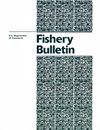Characterizing spawning behavior of Greenland halibut (Reinhardtius hippoglossoides) in the eastern Bering Sea and Aleutian Islands
IF 0.8
4区 农林科学
Q3 FISHERIES
引用次数: 2
Abstract
2 Department of Fisheries College of Fisheries and Ocean Sciences University of Alaska Fairbanks P.O. Box 757220 Fairbanks, Alaska 99775 Abstract—Understanding spawning behavior of commercial fish populations provides a basis for making management decisions related to these stocks. Archival tags can be used to define spawning behavior when depthspecific movements are involved. Spawning behavior of Greenland halibut (Reinhardtius hippoglossoides) in the eastern Bering Sea and the Aleutian Islands was inferred from archival tag data. The predominant period of identified spawning activity, based on abrupt vertical rises of females, occurred in January and February, and females reached apexes in their upward movement (spawning rises) at depths of approximately 200–350 m below the surface, indicating that the release of eggs could occur at depths shallower than previously assumed. Females had a single spawning rise annually, a result supporting the notion that this species is a total (singlebatch) spawner. Male Greenland halibut exhibited spawning behavior, rises to shallower depths one or more times, for an average of 20 d. For large female Greenland halibut (>80 cm in fork length), spawning rises occurred in consecutive years, indicating that, despite oocyte development taking more than 1 year, spawning occurs annually. Inferring spawning behavior by using data collected with archival tags can aid in understanding the maturity of Greenland halibut.格陵兰大比目鱼(Reinhardtius hippoglossoides)在白令海东部和阿留申群岛的产卵行为
摘要-了解商业鱼类种群的产卵行为为制定与这些种群相关的管理决策提供了依据。当涉及到深度特定的移动时,存档标签可以用来定义刷出行为。利用档案资料对格陵兰大比目鱼(Reinhardtius hippoglossoides)在白令海东部和阿留申群岛的产卵行为进行了推测。根据雌鱼垂直上升的突然趋势,确定的产卵活动的主要时期发生在1月和2月,雌鱼的向上运动(产卵上升)在地表以下约200-350米的深度达到顶峰,这表明产卵可能发生在比以前假设的更浅的深度。雌性每年只产卵一次,这一结果支持了这种物种是一次(单批)产卵者的观点。雄性格陵兰大比目鱼表现出产卵行为,上升到较浅的深度一次或多次,平均为20 d。对于大型雌性格陵兰大比目鱼(叉长约80 cm),产卵上升是连续几年发生的,这表明尽管卵母细胞发育需要1年以上的时间,但每年都会产卵。通过使用档案标签收集的数据来推断产卵行为可以帮助了解格陵兰大比目鱼的成熟度。
本文章由计算机程序翻译,如有差异,请以英文原文为准。
求助全文
约1分钟内获得全文
求助全文
来源期刊

Fishery Bulletin
农林科学-渔业
CiteScore
1.70
自引率
12.50%
发文量
76
审稿时长
>24 weeks
期刊介绍:
The quarterly Fishery Bulletin is one of the oldest and most respected fisheries journals in the world. It has been an official publication of the U.S. Government since 1881, under various titles, and is the U.S. counterpart to other highly regarded governmental fisheries science publications. It publishes original research and interpretative articles in all scientific fields that bear on marine fisheries and marine mammal science.
 求助内容:
求助内容: 应助结果提醒方式:
应助结果提醒方式:


